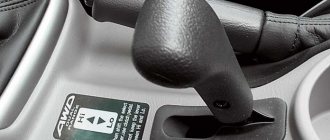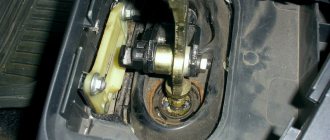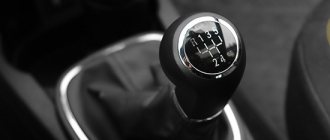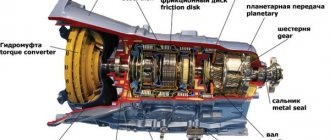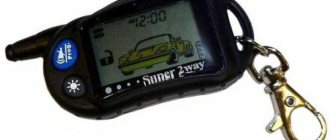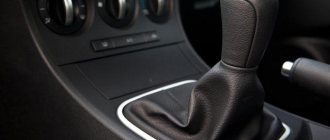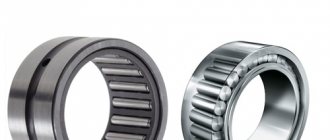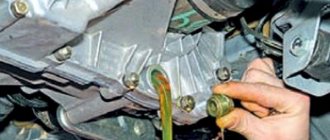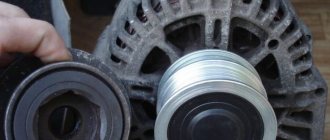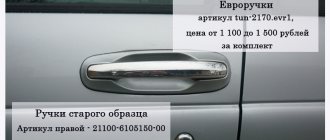Different cars, as a rule, are equipped with gasoline or diesel engines of different power, with different amounts of torque and, accordingly, different crankshaft speeds.
Also, regardless of the type of internal combustion engine, cars are equipped with different gearboxes. At the same time, for most gearboxes, such a concept as the main gear of a car is relevant. Next we will talk about what a final drive is and what it is needed for.
Types and their applicability
The main characteristic of the main gears is the type of gears and the type of tooth engagement between them. The following types of gearboxes are used on cars:
- Cylindrical
- Conical
- Hypoid
- Worm
Main gear types
Spur gears are used in the final drives of front-wheel drive cars. The absence of the need to change the direction of rotation allows the use of such a gearbox. The teeth on the gears are oblique or chevron.
The gear ratio for such gearboxes is in the range of 3.5-4.2. A larger gear ratio is not used, since this requires increasing the size of the gears, which is accompanied by an increase in the noise level of the transmission.
Types and design
So, let's look at the types of main gears of a car. On front-wheel drive cars, where the engine and gearbox are placed transversely relative to the body, a cylindrical design is used. This transmission has gears with chevron and oblique teeth. If we talk about the gear ratio, it can range from 3.5 to 4.2. If this figure is increased, this will lead not only to an increase in the dimensions of the structure, but also to an increase in the noise level.
Modern gearboxes use two or three output shafts. Each of them has its own main drive gear. All of them are engaged with one, the driven one. Thus, the main gear of this type can have several gear ratios at once. Robotic DSG gearboxes from Volkswagen also work according to this scheme.
Rear-wheel drive cars can use different mechanisms. So, it can be conical, worm and hypoid. Similar types are also found on all-wheel drive vehicles, but this only applies to those vehicles where the engine is located along the body. On modern crossovers, the rear axle can be driven like front-wheel drive cars through a viscous coupling. But that is another story.
About the differential
It is an integral part of the main gear. What is the differential used for? It interacts with the gear reducer. Structurally, the unit (main gear with differential) consists of:
- Driven gear.
- Half shafts.
- Drive gear.
- Satellites.
- Axle gears.
It is designed to distribute torque between the axle shafts of the wheels when turning the car. The differential allows the wheel to rotate at different angular speeds. In this case, the wheels spin without slipping, which contributes to safer cornering (especially in winter), eliminating the risk of skidding.
In other words, the differential receives 100% of the torque from the driveshaft. The incoming energy can be distributed either evenly, in a proportion of 50 to 50 (which is what happens during linear motion), or in other proportions. Depending on the road situation, one wheel can receive from 0 to 100% of the torque. As a rule, large run-ups occur when driving on bumpy terrain or in snow.
In the process of torque distribution, two gears of the satellites and axle shafts are used. They are lubricated in a common “bath” of the crankcase with transmission oil, which partially performs the function of cooling the parts, since the teeth constantly rub against each other.
Some people deliberately weld the differential on rear-wheel drive cars in order to make it easier to skid. Thus, the torque is always distributed in a proportion of 50 to 50. But uneven tire wear is also observed, since they always slip when cornering.
We also note that some passenger cars have an electronic differential lock installed as an additional option. This is necessary so that the car can get out of the mud or snow captivity. A similar blocking is present on all SUVs without exception.
Basic faults
- failure of the differential bearing - in gearboxes, bearings are used to allow the differential to rotate. This is the most vulnerable part that operates under critical loads (speed, temperature changes). When the rollers or balls wear out, the bearing emits a hum, the volume of which increases in proportion to the speed of the vehicle. Neglecting timely replacement of the bearing threatens to jam the gears of the main pair, which subsequently leads to the replacement of the entire assembly, including satellites and axle shafts;
- activation of the GP teeth and satellites. The rubbing surfaces of parts are subject to wear; with every hundred thousand kilometers, the teeth of a pair wear out, and the gap between them increases, leading to increased vibration and hum. For this purpose, adjustment of the contact patch is provided by placing spacer washers;
- cutting off the teeth of the gearbox and satellites - occurs if you often drive away with slipping;
- licking of the splined part on the axle shafts and satellites - natural wear and tear according to the mileage of the car;
- turning the axle bushing leads to the fact that the car will stand still in any gear and the gearbox will rotate;
- oil leak - possibly as a result of increased pressure in the differential housing due to a clogged breather or due to a leak in the gearbox cover.
Advantages and disadvantages
Any type of tooth connection has pros and cons.
Read also: Perfume for a young man
Positive and negative points:
- Cylindrical . The highest gear ratio is limited to 4.2. A subsequent increase in the ratio of the number of teeth will lead to an increase in transmission dimensions and an increase in noise.
- Hypoid. It stands out for its low load on the teeth and low noise level. However, due to the displacement in the fixation of the gears, sliding friction increases and the efficiency decreases, but at the same time it becomes possible to lower the cardan to the lowest possible height.
- Conical GP . Rarely used due to large dimensions and high noise level.
- Worm . In fact, it is not used due to its high cost.
How does the service work?
Gearbox maintenance is rarely done; usually everything is limited to changing the oil. At a mileage of over 150,000 km, the bearing may need to be adjusted, as well as the contact patch between the driven and drive gears
When changing the oil, it is extremely important to clean the cavity from wear products (small chips), as well as dirt. It is not necessary to use flushes for the axle gearbox; it is enough to use 2 liters of diesel fuel and let the unit run at low speeds
Tips on how to extend the performance of the GP and differential:
- change the oil in a timely manner, and if your driving style is more sporty, the car endures high loads (driving at high speed, transporting cargo);
- When changing the oil manufacturer or changing the viscosity, flush the gearbox;
- When driving over 200,000 km, it is recommended to use additives. Why is an additive needed? Molybdenum disulfide, contained in the additive, reduces friction of parts, as a result of which the temperature decreases, the oil retains its properties longer. Remember that if the main pair is heavily worn, there is no point in using an additive;
- Avoid starting with slipping.
main gear
The main gear serves to increase the overall gear ratio and transmit torque through the differential (or turning mechanism) and final drives to the drive wheels of the tractor (car).
Based on the number of pairs of gears, single and double main gears are distinguished, and by design - bevel with spiral teeth, hypoid and cylindrical.
The main transmission of the tractor is a single gear consisting of a pair of bevel or spur gears. The final drives of a car can be single or double. Single gears are bevel gears with hypoid gearing, which reduces noise during gear operation and reduces the overall dimensions and weight of the drive axle. They are used on light and medium-duty passenger cars.
Drawing. Types of main gears of tractors and cars: a - bevel with spur gearing; b - conical with helical gearing; c - conical with hypoid gearing.
Double final drives consist of a pair of bevel gears and a pair of spur gears. Bevel gears are made with a spiral tooth, and cylindrical gears are made with straight, oblique or chevron teeth.
Types of device
GPs differ in the number of gear stages. There are the following types of main gear:
- Single . It consists of driven and driving gears.
- Double . Has four gears. This type is installed in trucks, as they need a higher gear ratio.
Double can be central and separate. The central one is located in the drive axle housing, and the separate one is located in the hub of the drive wheels and the axle. GP differs in the type of tooth connection:
- cylindrical;
- hypoid;
- worm;
- canonical.
The most common signs of transmission failure
The most difficult transmission element to repair is the gearbox. The car owner should be wary of:
- difficulties when changing gears, crunching, creaking, other extraneous sounds when moving the lever to another position;
- it is impossible to engage the gear;
- a strong smell of engine oil appears in the cabin;
- rustling, knocking noises when the gear shift lever is in neutral.
An oil leak from the gearbox is a serious reason to immediately contact a specialist. Lack of lubrication can completely damage the mechanism.
Gearbox maintenance and troubleshooting
Below are links to articles that can help you find the information you need.
- What kind of oil to pour into the gearbox? Types of oils, viscosity, oil service life.
- How to remove/replace the gearbox? Step-by-step instructions for removing the gearbox.
- The gearshift lever is rattling, what should I do? We get rid of the rattling of the gearbox handle at 2.5-4 rpm.
- How to replace a malso in a gearbox? Step-by-step instructions for changing the oil in the box.
- How to check the oil level? About where the dipstick is on the box and how to check the level.
- How to replace the reverse sensor (RDS)? The reversing lights do not light up - most likely the sensor has failed. Detailed instructions for replacing the sensor.
- Reverse gear does not engage. What to do? The reasons for this problem and what can be done about it.
- Second gear crunches. The reasons for this problem and what can be done about it.
We hope you found answers to your questions.
Design and basic requirements for the main gear
The design of the mechanism in question is simple: the main gear consists of two gears (gear reducer). The drive gear is smaller in size, and it is connected to the output shaft of the gearbox. The driven gear is larger than the drive gear, and it is connected to the differential and, accordingly, to the wheels of the car.
Scheme of the main gear of the driving axle of the car: 1 – drive wheels;
2 – axle shaft; 3 – driven gear; 4 - drive shaft; 5-drive gear Let's consider the basic requirements for the main gear:
- minimum level of noise and vibration during operation;
- minimum fuel consumption;
- high efficiency;
- ensuring high traction and dynamic characteristics;
- manufacturability;
- minimum overall dimensions (to increase ground clearance and not raise the floor level in the car);
- minimum weight;
- high reliability;
- minimal need for maintenance.
The efficiency of the main gear can be increased by increasing the quality of manufacturing of the teeth of both gears, as well as by increasing the rigidity of the parts and using rolling bearings in the design. Note that it is most often necessary to reduce vibration and noise during operation for gear reducers of passenger cars. Vibrations and noise can be minimized by ensuring reliable lubrication of the teeth, increasing the accuracy of gear engagement, increasing the diameter of the shafts, and other measures that increase the rigidity of the mechanism elements.
GP care and maintenance
A malfunction of the GP, that it is not working properly, may be indicated by knocking, noise and other extraneous sounds, a high level of vibration, the appearance of backlash, heating, and an increase in mechanical losses. All this becomes a consequence of wear of the gear teeth or breakage of some of them. Frequent component breakdowns include wear of bearings, loosening of fasteners, and failure to adjust gear pairs.
As for maintenance, the GP is an easy-to-maintain element, for its normal operation it is enough to regularly check the oil level and change it in a timely manner. Experts also advise systematically adjusting the GP, contacting certified service centers for this.
As part of the maintenance, inspection work is carried out, the reliability of fastenings and the tightness of connections at points of contact with the crankcase are checked. It is important to monitor the oil level - ideally it should be level with the edge of the hole.
GP on rear wheel drive cars
Other types of final drives are installed on rear-wheel drive cars, since the engine and gearbox are parallel to the drive, and torque is supplied to the drive axle vertically.
Rear-wheel drive cars most often have a hypoid gear, which has the least load on the tooth and creates a minimum degree of noise. During operation, the efficiency decreases, since the displaced fastenings of the gear wheels increase the coefficient of friction during sliding.
On cars with a hypoid gearbox, the gear ratio is 3.5 - 5.4, on trucks 5 - 7. This gear differs from a cylindrical gear: the shaft axis does not intersect with the gear, because the shape allows the cardan to be lowered and the body clearance to be reduced, this leads to maximum vehicle stability.
If the car owner is not interested in the size and degree of noise, then a canonical type GP is used. Worm gears are installed very rarely, since their production is labor-intensive and expensive.
For normal functioning of rubbing elements and teeth, lubrication is required. Special oil is poured into the crankcase or rear axle. Its level must be monitored to ensure stable operation of machine elements.
Required care
Any gears of the main gear and self-block need lubrication and maintenance. Despite the fact that all elements of the GP and self-block look like powerful pieces of hardware, they still have their own durability resource. Because of this, advice regarding sudden starts and braking, rough clutch engagement and other vehicle loads remain relevant today.
All rubbing elements and gear teeth must be lubricated regularly. Because of this, special oil is poured into the crankcase, the level of which must be checked occasionally.
The oil in which the gears operate can leak through weak connections and worn-out seals.
If there is any doubt about the occurrence of any malfunction in the transmission, it is necessary to raise the drive wheel of the machine using a jack. Start the motor and gear to rotate the wheel. Look at all the rotating parts, listen for any strange or suspicious noise.
Then you should jack up the other wheel. If there is significant noise, vibration or oil droplets, you must contact a car service center.
Primary requirements. Modern tendencies
The main gears are subject to many requirements, the main ones being:
- Reliability;
- Minimal maintenance required;
- High efficiency indicators;
- Smooth and silent;
- Minimum possible overall dimensions.
Naturally, there is no ideal option, so designers have to look for compromises when choosing the type of final drive.
It is not yet possible to abandon the use of final drives in transmission designs, so all developments are aimed at increasing performance indicators.
It is noteworthy that changing the operating parameters of the gearbox is one of the main types of transmission tuning. By installing gears with a changed gear ratio, you can significantly influence the dynamics of the car, maximum speed, fuel consumption, load on the gearbox and power unit.
Finally, it is worth mentioning the design features of dual-clutch robotic gearboxes, which also affects the final drive design. In such gearboxes, paired and unpaired gears are separated, so there are two secondary shafts at the output. And each of them transmits rotation to its own drive gear of the main gear. That is, in such gearboxes there are two driving gears, and only one driven gear.
DSG gearbox diagram
This design feature allows you to make the gear ratio on the gearbox variable. To do this, only drive gears with different numbers of teeth are used. For example, when using a number of unpaired gears, to increase traction, a gear is used that provides a larger gear ratio, and the gear of a paired row has a lower value of this parameter.
Purpose, design features
The main task of this element is to change the torque before applying it to the wheel drive. The gearbox does the same, but it has the ability to change gear ratios by engaging certain gears. Despite the presence of a gearbox in the design of the car, the torque output from it is small, and the rotation speed of the output shaft is high. If you transfer rotation directly to the drive wheels, the resulting load will “crush” the engine. In general, the car simply will not budge.
The final drive of the car provides increased torque and reduced rotation speed. But unlike a gearbox, its gear ratio is fixed.
The location of the final drive using the example of a conventional manual transmission
This transmission on a passenger car is a conventional single-stage constant mesh gearbox, consisting of two gears of different diameters. The drive gear is small in size and is connected to the gearbox output shaft, that is, rotation is supplied to it. The driven gear is much larger in size and it supplies the resulting rotation to the drive shafts of the wheels.
The gear ratio is the ratio of the number of gear teeth in the gearbox. For passenger cars this parameter is in the range of 3.5-4.5, and for trucks it reaches 5-7.
The higher the gear ratio (the greater the number of teeth on the driven gear relative to the drive gear), the higher the torque supplied to the wheels. In this case, the tractive effort will be greater, but the maximum speed will be lower.
The main gear ratio is selected based on the performance indicators of the power plant, as well as other transmission components.
The final drive design directly depends on the design features of the car itself. This gearbox can be either a separate unit installed in its own housing (rear-wheel drive models) or be part of the gearbox design (cars with front-wheel drive).
Final drive in a rear-wheel drive car
As for some all-wheel drive cars, they may use a different layout. If in such a car the location of the power plant is transverse, then the main gear of the front axle is included in the design of the gearbox, and the rear axle is located in a separate housing. In a car with a longitudinal layout, the main gears on both axles are separated from the gearbox and transfer case.
In models with a separate main gear, this gearbox performs one more task - it changes the angle of rotation by 90 degrees. That is, the gearbox output shaft and wheel drive shafts are perpendicular.
Audi front axle final drive location
In front-wheel drive models, where the main gear is included in the gearbox design, these shafts are parallel, since there is no need to change the direction angle.
A number of trucks use two-stage gearboxes. It is noteworthy that their design can be different, but the most widespread is the so-called spaced layout, which uses one central gearbox and two wheeled (on-board) gearboxes. This design allows you to significantly increase the torque and, accordingly, the traction force on the wheels.
Drive cars
The peculiarity of the gearbox is that it evenly divides the rotation between both drive shafts. For straight-line motion, this condition is normal. But when cornering, the wheels of the same axle travel different distances, so it is necessary to change the rotation speed of each of them. This is the job of the differential used in the transmission design (it is installed on the driven gear). As a result, the main gear supplies rotation to the drive shafts not directly, but through the differential.
Where is?
We seem to have figured out the purpose of the car’s main gear; now it would be nice to find it. Doing this can be a difficult task, because the location of this unit can be different and depends on the type of machine drive and the imagination of the development engineers.
Fortunately, the flight of thoughts here is limited by the number of axes. So, for example, if we have front-wheel drive, then in this case the main gear of the car should be looked for in the gearbox along with the differential, in vehicles with rear drive wheels - directly in the rear axle. If all four are leading, then choose one of the above options.
Replacing wheelsets
Often standard wheels are not enough to overcome serious off-road conditions. When installing special rubber, the main pair is usually replaced. The characteristics of standard wheelsets are designed specifically for the use of factory tires. If you don't replace the wheelsets when switching to larger wheels, they won't last long.
When installing military bridges, the main thing is to be aware of why you need a car. If it was purchased exclusively for off-road use, then a military bridge is the best solution. For a car that will have to be used frequently on the highway, this is not the best choice.
Single final drives
Single final drives consist of one pair of gears.
The cylindrical main gear is used in front-wheel drive passenger cars with a transverse engine and is located in a common crankcase with a gearbox and clutch (see VAZ and AZLK twin-shaft gearboxes, Figure 2). Its gear ratio is 3.5...4.2, and the gears can be spur, helical and chevron. The cylindrical main gear has a high efficiency - at least 0.98 , but it reduces the vehicle's ground clearance and is noisier.
The bevel final drive (Figure 2, a) is used on passenger cars and light and medium-duty trucks. The axes of the driving 1 and driven 2 gears in the bevel main gear lie in the same plane and intersect, and the gears are made with spiral teeth. The transmission has increased strength of gear teeth, is small in size and allows for a lower center of gravity of the vehicle. The efficiency of the bevel main gear with a spiral tooth is 0.97...0.98 . The gear ratios of bevel main gears are 3.5...4.5 for passenger cars and 5...7 for trucks and buses.
Figure 2 - Main gears
a, b, c - single; g, d - double; e - gearbox; 1 - drive gear; 2 — driven gear; 3 - worm; 4 - worm gear; 5 - bevel gear; 6 — cylindrical gears; 7 — axle shaft; 8 — sun gear; 9 — satellite; 10 - axis; 11 — ring gear; l – hypoid displacement
The hypoid final drive (Figure 2, b) is widely used in cars and trucks. The axes of the drive 1 and driven 2 gears of the hypoid main gear, unlike the bevel gear, do not lie in the same plane and do not intersect, but intersect. The transmission can be with upper or lower hypoid displacement l. A top-biased hypoid final drive is used on multi-axle vehicles, since the drive gear shaft must be through, and on front-wheel drive vehicles, based on the layout conditions. The final drive with lower hypoid displacement is widely used in passenger cars.
The gear ratios of hypoid main gears for passenger cars are 3.5...4.5, and for trucks and buses 5...7. The hypoid main gear is more durable and quiet than others, has high smoothness of engagement, is small in size and can be used on trucks instead of a double main gear. It has an efficiency equal to 0.96...0.97 . With a lower hypoid offset, it is possible to position the driveshaft lower and lower the vehicle’s center of gravity, increasing its stability. However, the hypoid final drive requires high precision manufacturing, assembly and adjustment. Due to the increased sliding of gear teeth, it also requires the use of special hypoid oil with sulfur, lead, phosphorus and other additives that form a strong oil film on the gear teeth.
The worm main gear (Figure 2, c) can be with an upper or lower location of the worm 3 relative to the worm gear 4, has a gear ratio of 4...5 and is currently rarely used. It is used on some multi-axle, multi-wheel drive vehicles. Compared to other types, the worm final drive is smaller, quieter, provides smoother engagement and minimizes dynamic loads. However, the transmission has the lowest efficiency ( 0.9...0.92 ) and is the most expensive in terms of labor intensity of manufacturing and the materials used (tin bronze).
Gear ratios (row)
Gear ratios are the gears of each gear, which also have their own size.
Gear ratios characterize the speed characteristics of a car in a particular gear. In a standard VAZ, the following numbers are used:
| Gearbox ratios: | |
| I | 3,636 |
| II | 1,95 |
| III | 1,357 |
| IV | 0,941 |
| V | 0,784 |
| reverse | 3,53 |
The characteristics shown above are just with standard gear ratios.
The standard range on the 2114 is far from ideal: First gear is too short – second gear is too long. Due to this, there is a sharp drop in dynamics when switching from first to second. Not only is there a failure, but when switching sharply, the second gear synchronizer slowly dies.
Therefore, there are sports series where the gap between 1st and 2nd is removed, and not only: sports series are selected according to the type of engine: it can just be a good city engine, or a sports one, or tailored for 402-meter racing. There are also “turbo” gears - designed for a turbo engine.
Principle of operation
The essence of the operation of the GP is simple: if the car is moving, the torque from the motor is transmitted to the gearbox, and then, using a transmission and a self-locking unit, to the drive shafts of the car. As a result, the GP directly changes the torque transmitted to the wheels of the car, so with its help the dynamics of wheel rotation also changes.
The main feature is the gear ratio. The parameter shows the ratio of the number of teeth of the driven gear to the driving gear. If it is higher, then the car reaches maximum speed very quickly. However, the highest speed index decreases.
Reducing the gear ratio increases the greatest dynamics; the car picks up speed more slowly. For a particular model, the gear ratio is selected taking into account the technical characteristics of the engine, gearbox, wheel dimensions, brake system, etc.
Types of car transmissions
The type of transmission system depends on the energy source and the method of transmitting torque from the internal combustion engine to the wheels of the vehicle. Automakers produce vehicles with several types of transmissions:
- mechanical;
- hydromechanical;
- electrical;
- hybrid.
Mechanical
The most common type of power transmission, present in all cars with a manual gearbox and clutch unit. The rotation of the crankshaft is transmitted through the clutch discs to the gearbox and other transmission units.
Hydromechanical
It is gaining popularity due to the widespread use of automatic transmissions in new car models. Mechanical rotation is transformed into fluid (oil) movement in the torque converter, a more advanced clutch replacement. The transmission of torque through the transformer is smoother.
We recommend: Replacing silent blocks: go to a car service center or do it yourself?
Electric
Used in electric cars and cars with hybrid power plants. In the first case, electricity from the battery powers an electric motor that rotates the wheels. Autohybrids are equipped with two types of power plants: internal combustion engines, electric motors, and batteries. Some car models use an internal combustion engine only after accelerating to a certain speed; up to this point, the wheels are turned by electric current. Some solutions allow you to constantly move with the help of electric motors, using a low-power gasoline engine only to recharge the batteries.
Advantages and disadvantages
Each type of gear connection has its own advantages and disadvantages.
- Cylindrical main gear. The maximum gear ratio is limited to 4.2. A further increase in the ratio of the number of teeth leads to a significant increase in the size of the mechanism and an increase in the noise level.
- The main gear is hypoid. This type has low tooth load and low noise level. Along with this, due to the displacement in the meshing of the gears, sliding friction increases and efficiency decreases, but at the same time it becomes possible to lower the driveshaft as much as possible. Gear ratio of passenger cars - 3.5-4.5; for freight - 5-7;
- Bevel main gear. It is rarely used due to its enormous size and noise.
- Worm main gear. In fact, this type of gear connection is not used due to labor intensive manufacturing and high cost.
The main gear is an important part of the transmission, on which fuel consumption, high speed and acceleration time of cars depend. Therefore, based on this, when tuning a transmission, several gears are often replaced with a modernized version. This helps reduce the load on the gearbox and clutch, and improve acceleration dynamics.
How is the GP structured?
What does the main gear consist of:
- bevel gear;
- bevel wheel.
The gear is the driving part (the thrust from the gearbox and the engine is attached to it), and the wheel is the driven element (it receives the thrust from the gear and transmits it at an angle of 90°).
Gears are made with teeth in the form of a spiral, because of this their hardness and number increase. At the same time, they are meshed, and the gears operate smoothly and without noise.
This is interesting: How to determine the exact size of a car's tires? Explanation of 5 markings
In addition to a bevel gear transmission with axes that intersect each other, the machine uses a hypoid transmission. Here the teeth have a certain design and the axis of a small bevel gear. It is shifted downward relative to the center of the largest gear by a certain distance.
This allows you to place the driveshaft lower and reduce the height of the convex upper part of the tunnel for positioning the shaft on the underbody, thereby increasing the area of the car interior.
It becomes possible to slightly reduce the center of gravity of the machine and increase its stability. Hypoid transmission has significant smoothness, high tooth strength and wear resistance.
Excerpt characterizing the main gear
“Yes,” Sonya said quietly. Natasha smiled enthusiastically. - No, Sonya, I can’t do it anymore! - she said. “I can’t hide it from you anymore.” You know, we love each other!... Sonya, my dear, he writes... Sonya... Sonya, as if not believing her ears, looked at Natasha with all her eyes. - And Bolkonsky? - she said. - Oh, Sonya, oh, if only you could know how happy I am! - Natasha said. – You don’t know what love is... – But, Natasha, is it really all over? Natasha looked at Sonya with big, open eyes, as if not understanding her question. - Well, are you refusing Prince Andrei? - said Sonya. “Oh, you don’t understand anything, don’t talk nonsense, just listen,” Natasha said with instant annoyance. “No, I can’t believe it,” Sonya repeated. - I don't understand. How did you love one person for a whole year and suddenly... After all, you only saw him three times. Natasha, I don’t believe you, you’re being naughty. In three days, forget everything and so... “Three days,” said Natasha. “It seems to me that I have loved him for a hundred years.” It seems to me that I have never loved anyone before him. You can't understand this. Sonya, wait, sit here. – Natasha hugged and kissed her. “They told me that this happens and you heard correctly, but now I have only experienced this love.” It's not what it used to be. As soon as I saw him, I felt that he was my master, and I was his slave, and that I could not help but love him. Yes, slave! Whatever he tells me, I will do. You don't understand this. What should I do? What should I do, Sonya? - Natasha said with a happy and frightened face. “But think about what you’re doing,” said Sonya, “I can’t leave it like that.” These secret letters... How could you let him do this? - she said with horror and disgust, which she could hardly hide. “I told you,” Natasha answered, “that I have no will, how can you not understand this: I love him!” “Then I won’t let this happen, I’ll tell you,” Sonya screamed with tears breaking through. “What are you doing, for God’s sake... If you tell me, you are my enemy,” Natasha spoke. - You want my misfortune, you want us to be separated... Seeing this fear of Natasha, Sonya cried tears of shame and pity for her friend. - But what happened between you? – she asked. -What did he tell you? Why doesn't he go to the house? Natasha did not answer her question. “For God’s sake, Sonya, don’t tell anyone, don’t torture me,” Natasha begged. – You remember that you cannot interfere in such matters. I opened it for you...
